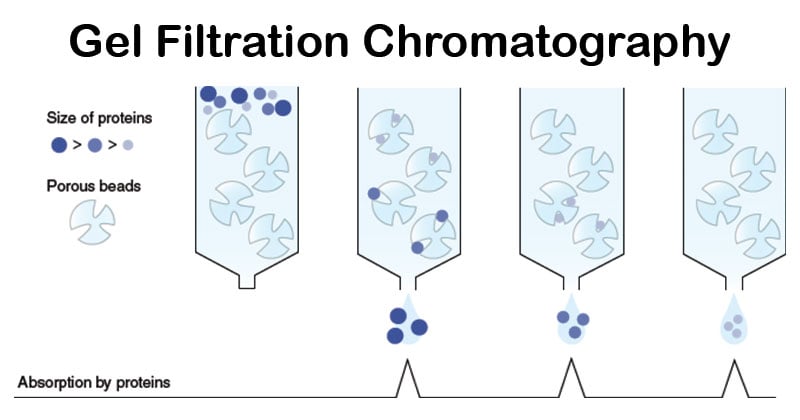Biomolecules are purified using different techniques that separate them according to the differences in their specific properties such as size, hydrophobicity, biorecognition, charge, etc.
Gel filtration is a technique in which the separation of components is based on the difference in molecular weight or size.
It is the simplest and mildest of all the chromatography techniques and separates molecules on the basis of differences in size.
Interesting Science Videos
Principle of Gel Filtration Chromatography

Image Source: MBL Life Science.
To perform a separation, the gel filtration medium is packed into a column to form a packed bed. The medium is a porous matrix in the form of spherical particles that have been chosen for their chemical and physical stability, and inertness (lack of reactivity and adsorptive properties). The packed bed is equilibrated with a buffer which fills the pores of the matrix and the space in between the particles. The liquid inside the pores is sometimes referred to as the stationary phase and this liquid is in equilibrium with the liquid outside the particles, referred to as the mobile phase.
- The stationary phase used is a porous polymer matrix whose pores are completely filled with the solvent to be used as the mobile phase.
- The molecules in the sample are pumped through specialized columns containing such microporous packing material (gel).
- The basis of the separation is that molecules above a certain size are totally excluded from the pores, while smaller molecules access the interior of the pores partly or wholly.
- The flow of the mobile phase hence will cause larger molecules to pass through the column unhindered, without penetrating the gel matrix, whereas smaller molecules will be retarded according to their penetration of the gel.
Types of Gel Filtration Chromatography
Group Separations
- The components of a sample are separated into two major groups according to the size range.
- A group separation can be used to remove high or low molecular weight contaminants (such as phenol red from culture fluids) or to desalt and exchange buffers.
High-resolution fractionation of biomolecules
- The components of a sample are separated according to differences in their molecular size.
- High-resolution fractionation can be used to isolate one or more components, to separate monomers from aggregates, to determine the molecular weight or to perform a molecular weight distribution analysis.
Steps in Gel Filtration Chromatography
- Spherical particles of gel filtration medium are packed into a column.
- The sample is applied to the column.
- Buffer (mobile phase) and sample move through the column.
- Molecules diffuse in and out of the pores of the matrix (also described as the partitioning of the sample between the mobile phase and the stationary phase).
- Smaller molecules move further into the matrix and so stay longer on the column.
- As buffer passes continuously through the column, molecules that are larger than the pores of the matrix are unable to diffuse into the pores and pass through the column.
- Smaller molecules diffuse into the pores and are delayed in their passage down the column.
- Separation occurs at different intervals which are followed by detection of components.
Applications of Gel Filtration Chromatography
- Gel filtration plays a key role in the purification of enzymes, polysaccharides, nucleic acids, proteins, and other biological macromolecules.
- Gel filtration can also be used to facilitate the refolding of denatured proteins by careful control of changing buffer conditions.
- It is used in protein fractionation experiments.
- Gel filtration technique is also used in molecular weight determination.
- Separation of sugar, proteins, peptides, rubbers, and others on the basis of their size.
- Can be used to determine the quaternary structure of purified proteins.
Advantages of Gel Filtration Chromatography
- Gel filtration is a robust technique that is well suited to handling biomolecules that are sensitive to changes in pH, the concentration of metal ions or co-factors and harsh environmental conditions.
- A significant advantage of gel filtration is that conditions can be varied to suit the type of sample or the requirements for further purification, analysis or storage without altering the separation.
- Separations can be performed in the presence of essential ions or cofactors, detergents, urea, guanidine hydrochloride, at high or low ionic strength, at 37 °C or in the cold room according to the requirements of the experiment.
- Unlike ion exchange or affinity chromatography, molecules do not bind to the chromatography medium so buffer composition does not directly affect resolution (the degree of separation between peaks).
- Short analysis time.
- Well defined separation.
- Narrow bands and good sensitivity.
- There is no sample loss.
- The small amount of mobile phase required.
- The flow rate can be set.
Limitations of Gel Filtration Chromatography
- The limited number of peaks that can be resolved within the short time scale of the run.
- Filtrations must be performed before using the instrument to prevent dust and other particulates from ruining the columns and interfering with the detectors.
- The molecular masses of most of the chains will be too close for the separation to show anything more than broad peaks.
References
- http://kirschner.med.harvard.edu/files/protocols/GE_gelfiltration.pdf
- Wilson, K., Walker, J. (2018). Principles and Techniques of Biochemistry and Molecular Biology (8 eds.). Cambridge University Press: New York.
- https://www.slideshare.net/asabuwangwa/gel-permeation-chromatography-gpc
- http://www.materials-talks.com/blog/2016/08/30/an-introduction-to-gel-permeation-chromatography-in-30-minutes/
- https://chromatography.conferenceseries.com/events-list/applications-of-chromatography
- http://library.umac.mo/ebooks/b28050630.pdf
- https://www.ncbi.nlm.nih.gov/pmc/articles/PMC5206469/
